Text
So Another thought I just had
Tabaxi are canonically filled with wanderlust-so it’s not too far of a reach for them to be largely canonically nomadic clans and families. They just set up shop where ever suits them for that season and once they get itchy feet, they pull of stakes and go searching for a change of scenery.
Tieflings are reinforced that they have a lack of culture. They’re born tiefs sometimes into normal human families and usually have trouble connecting with either sides of their parent’s culture. So many tieflings end up spending their lives sort of wandering around, trying to find an amicable place to settle where people won’t throw rocks at them and they can work on figuring out who they are as a person in relative peace
I’m just saying-it would not be uncommon for Nomadic Tabaxi clans to welcome Tieflings in their groups with open arms. Cause for one, safety in numbers, the bigger the clan the safer it is, every able bodied person makes the clan stronger. Second-would you tell me that the Tabaxi would not be very open minded people? It’s canon they love going around and learning new things and having new experiences. They would absolutely be chill as fuck with tieflings rolling with them-there is no time to be RACIST when you’re a tabaxi! Life is short there is so much to learn and you cannot learn anything if you’re rude to people who have horns and hoofies. They will also know THINGS and they won’t tell you things if you’re racist to them.Three-tieflings are about that ‘found family trope’ most tiefs aren’t welcomed or accepted by their biological family and this traveling clan of cat people just immediately start vibing you with you? And supporting you? and having an interest in your experiences and stories you have to tell? And they are soft and warm and full of love and maybe bees because they make that buzzing noise when they’re happy?
I’m also just saying there also may be some tieflings with catlike traits because they interbred with tabaxi folk and have made…..HELL CATS. TIEFLINGS BUT THEY ALWAYS LAND ON THEIR FEETS. TABAXI BUT THEY ARE FIRE PROOF AND KNOW HELLISH REBUKE. HELL CATS!
683 notes
·
View notes
Text
More inadvisable secret societies for your Dungeons & Dragons game:
The Brotherhood of the Crimson Star, an apocalypse cult with a decentralised cell structure. Approximately half of the Brotherhood’s cells are working to accelerate the prophesied apocalypse, while the other half are working to prevent it. Owing to tight information control and erratic communication between cells, most members are completely in the dark about the schism, believing that all of their peers share their goals and and merely disagree in their methods.
The Golden Owlbear Society, a philosophical collective of like-minded wizards and warriors dedicated to the improvement of mortal civilisation. In practice, they’re a social club for retired high-level adventurers who like to get high on pipeweed and debate political theory, and they almost never accomplish anything of note, but they’re treated as an existential threat by many nations owing to the absurdly high concentration of power they in theory represent.
The Thousand Scales, a sorcerous cabal united by the fact that they’re all the illegitimate offspring of a single incredibly randy dragon. The half-human members serve as the organisation’s public face, while the greater part of its roster keep out of the public eye owing to their… eclectic parentage. The cabal’s leader appears to be half dragon, half horse, but guests should under no circumstances remark on this – it’s something of a touchy subject!
The Vitalist League, ostensibly a band of freedom fighters against the reign of a terrible lich-king. In truth, nearly all of the League’s members are disguised undead infiltrators of various sorts. Most of the infiltrators are aware of this fact, but their superiors generally are not; due to the lich-king’s habit of regularly purging the upper ranks of his secret police, the infiltration’s operational history has been lost, and it’s unclear whether the “original” human-led League ever existed in the first place.
The Honourable Company of Shoemakers, a trade guild that wields immense political power due to its deep connections and numerous highly trained operatives. Their secret is that they really are just a bunch of shoemakers, and have no ambitions or concerns beyond protecting the exclusivity of their contracts and ensuring that their members are allowed to ply their trades unimpeded by state interference. The trouble is, they’ll go to literally any lengths to achieve those goals!
8K notes
·
View notes
Photo
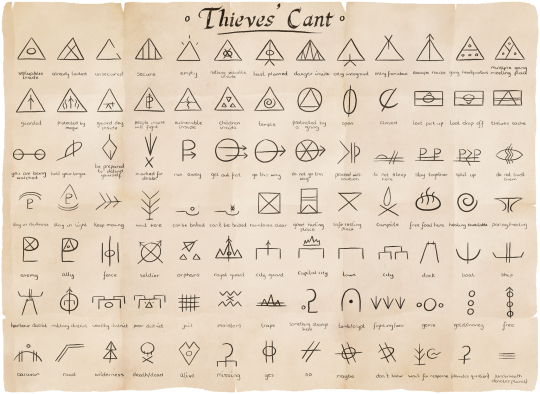
a big ass thieves cant collection for my dnd game. some of it inspired by all those ‘hobo symbols’ and stuff you can find on the internet
17K notes
·
View notes
Photo

a big ass thieves cant collection for my dnd game. some of it inspired by all those ‘hobo symbols’ and stuff you can find on the internet
17K notes
·
View notes
Photo

posted this on reddit and people really seemed to like it. so now it’s on tumblr, as well!
reddit link
gmbinder link
3 notes
·
View notes
Photo

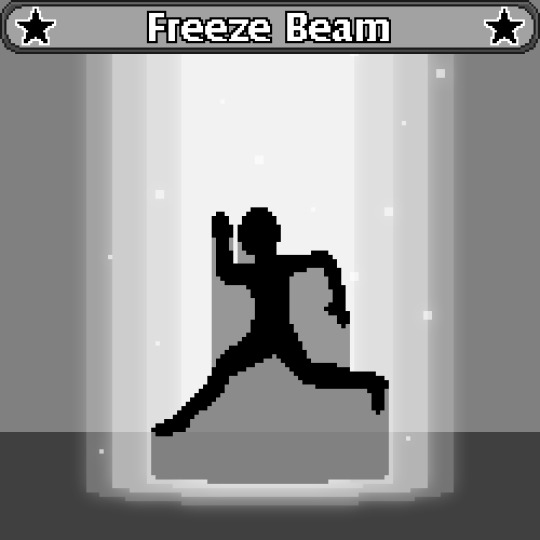
i drew 2 (two) of them spells bc i wanted to

i made some very bad, no good, no-bueno spells! link to gmbinder
please tell me how bad they are bc i have no clue about balancing and shit and i want to know if these are ok or not
6 notes
·
View notes
Photo

i made some very bad, no good, no-bueno spells! link to gmbinder
please tell me how bad they are bc i have no clue about balancing and shit and i want to know if these are ok or not
6 notes
·
View notes
Photo
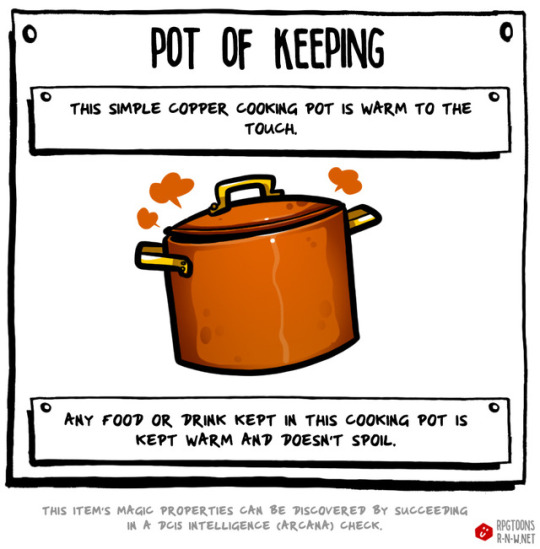
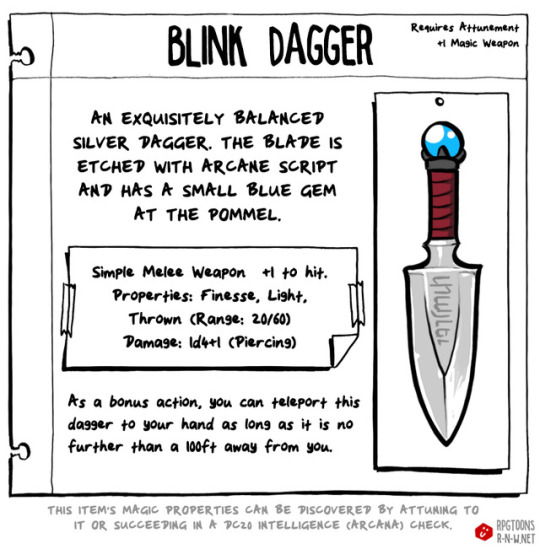
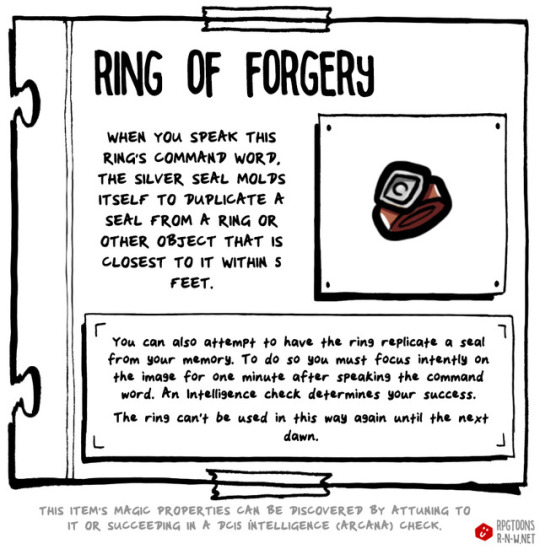
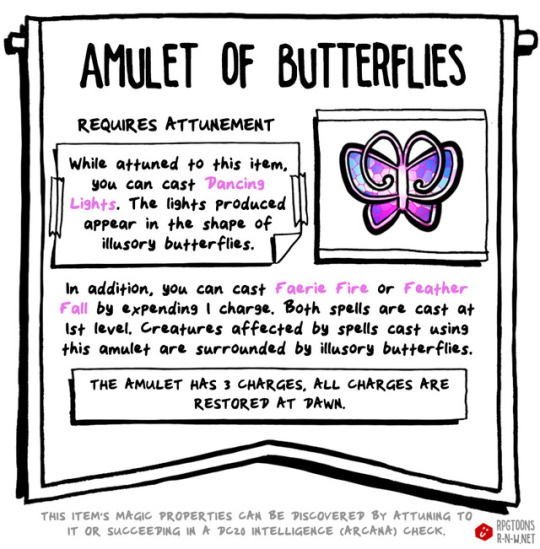

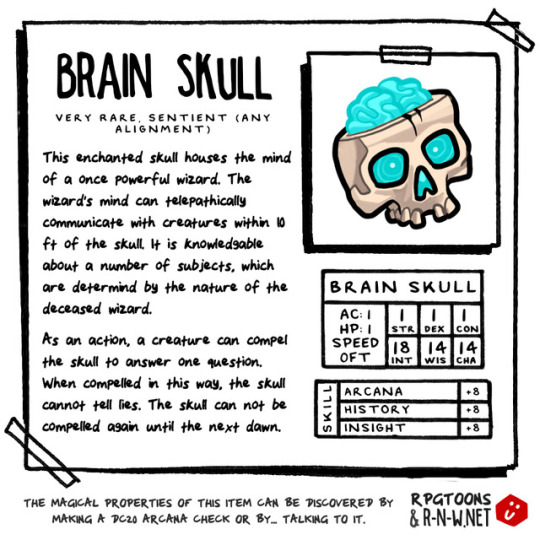
The six most popular items we made in 2017! ~ Posting a new one every Sunday.
Item cards made in collaboration with @r-n-w
More of our stuff here.
#yo lau#yo boner boy#yall should stop looking at my dm blog#bc im definitely using this ajsjwinsjzbzje#items#magic
5K notes
·
View notes
Text
Okay, buckle up buckaroos, because today I met an honest-to-goodness cryptid.
I was out running errands and I made a stop at Intimate Books (…for a friend), and on my way out I realized that the bookshop next door was open.
This bookshop has existed for more than a hundred years, and in all my life it has NEVER BEEN OPEN. I mean, I assume it has to be open sometimes, but never at any normal, reasonable hour. Everyone says it’s a front for the mob or something.
So what do you do when the weird mafia bookshop is open? You go the fuck inside.
The first thing I noticed was the smell. You know that smell when you accidentally leave your towel on the bathroom floor all day and you come back to that mildew funk? The shop smelled like that times a thousand. I expected to see stuff growing on the walls, but the books were pristine. We’re talking first editions, rare editions, weird Bibles and books inscribed to really famous dead people. Librarians would weep for the chance to accession this place. In the first two minutes I found a signed copy of The Crucible and what I think was a first edition of Blake’s Book of Thel.
Then a clerk showed up out of nowhere—honestly nowhere. He looked EXACTLY like a bookseller should look, kind of fluffy and bewildered and really, really gay.
“Are you lost?” was the first thing he said to me.
“Nope. Just browsing, thanks.”
“Browsing, I see. Erm. How do you feel about snakes?” he asked. And without waiting for me to answer, he just walked away and vanished around a shelf.
I figured it was a metaphor, or a code phrase for the mafia. Until I turned a corner like ten minutes later and found a little reading nook. It was really pretty, although I feel like that particular window should have been on an interior wall? Anyway, curled up in an armchair in a patch of sunlight was the biggest fuck-off black snake I have ever seen.
Like, I don’t mind snakes in general. But in their normal context, right? Outside. On the ground. Not six feet long and sitting on a threadbare velvet armchair like it owns the place.
I was about to turn around and leave, but I saw a gorgeous first-edition copy of Leaves of Grass on a shelf, a little too close to the snake for comfort. But I had never needed anything so badly in my life.
So I went back to the counter to buy it, but the clerk was nowhere to be found.
While I was waiting, I noticed a collection of pictures hanging on the wall behind the counter, dating back to the very dawn of photography. A couple were of this rock-star looking guy from the 70s that I should probably have recognized, but there were authors and landscapes and stuff, too. There was even an old tintype portrait of Oscar freaking Wilde, sitting in this very shop with a guy that I would ACTUALLY SWEAR was the clerk from before. Like, I know my family all has the same nose, but this guy had the same everything.
After approximately one year of waiting, the clerk came back out to the desk. By now I’ve realized that he’s too bad at his job to be anything but the owner of the shop.
“I saw your snake,” I told him.
“Did you? Was he behaving himself?”
“He was sleeping.”
“Yes, he enjoys that.”
“Does he just stay out in the open like that? What if he gets out?”
He shrugged and smiled. “He always comes home again, the dear boy.”
Right, a homing snake. That’s totally normal.
Then he cleared his throat and asked, in a weirdly reluctant voice, if I was going to buy the Whitman.
“Yes, please,” I told him. “I saw it on a shelf by the snake, and it was just too tempting.”
He sighed. “Oh, yes, I expect it was.”
When I started to hand him my card, he went all fluttery and said that they didn’t take cards.
All right, fine. I had some cash on me, but I told him that he’d sell a lot more books if he got a Square or something.
He got this scandalized look on his face and went, “Why would I want to do that?”
Oookay. I handed over the cash and he popped open the ancient till and started making change.
In shillings. Shillings! I swear to god I saw Queen Anne’s face on one of them. The silver value of the coins was probably as much as I paid for the book.
But I had to have proof that this happened—at that point, all I had was a book in a plain brown wrapper, not appreciably different from what I bought next door. So I asked him for a receipt.
He looked delighted and wrote one up for me.
By hand.
With a fountain pen.
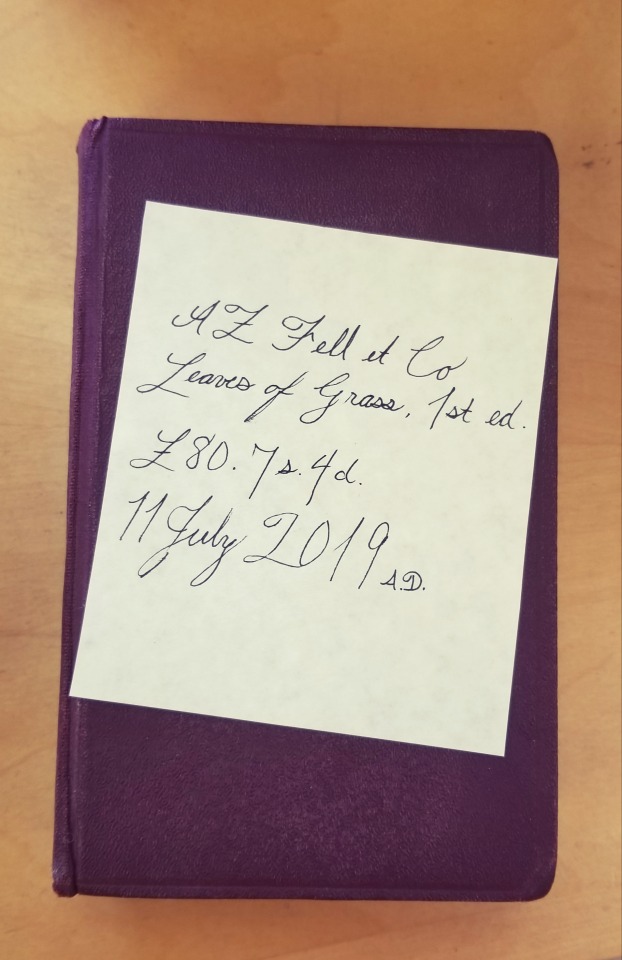
And that’s the story of how I met a bookseller cryptid and his pet snake.
55K notes
·
View notes
Photo
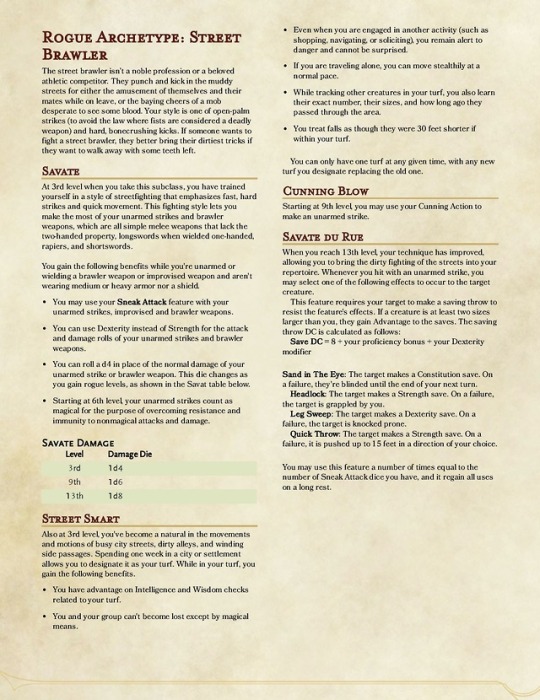
[D&D 5e Homebrew] Roguish Archetype: Street Brawler
“What this is, is a recent attempt to whip up an unarmed rogue. I always liked the idea and wanted to try (again) to see if I could do it.
This particular variety is partly based on the French martial art, Savate. It is a hard, striking style of boxing that employs kicks and slaps. Closed fists were considered deadly weapons, after all, so the French sailors who created it wanted to avoid getting a more severe penalty for fighting. It also employs dirty fighting, because sailors. I also added another French peculiarity, specifically Parkour, as a fun exploration ability in the class.
Here is the link to the subclass on Homebrewery: https://homebrewery.naturalcrit.com/share/BybtG-ot1S“
– by user Ninjadeadbeard at GitP Forums.
145 notes
·
View notes
Photo

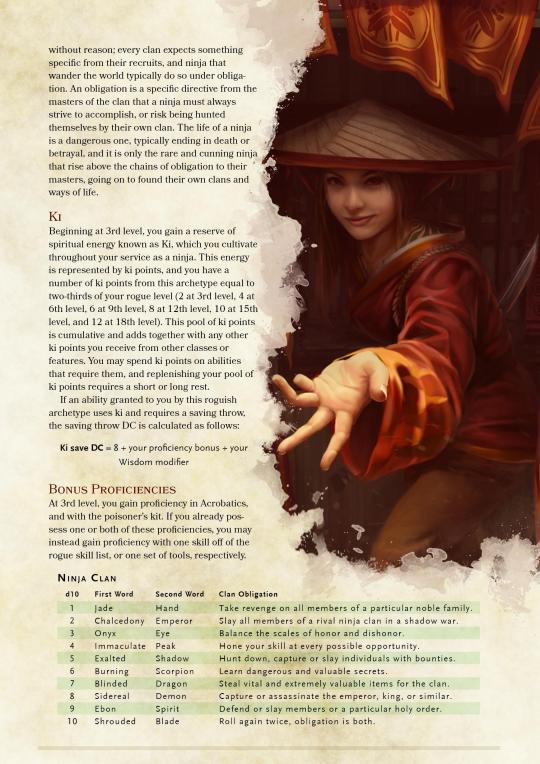
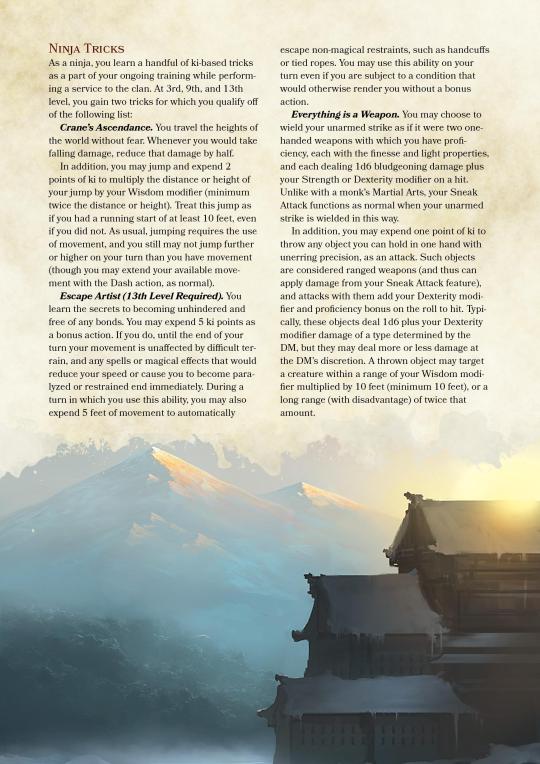


Ninja Rogue by The_Singular_Anyone
2K notes
·
View notes
Photo
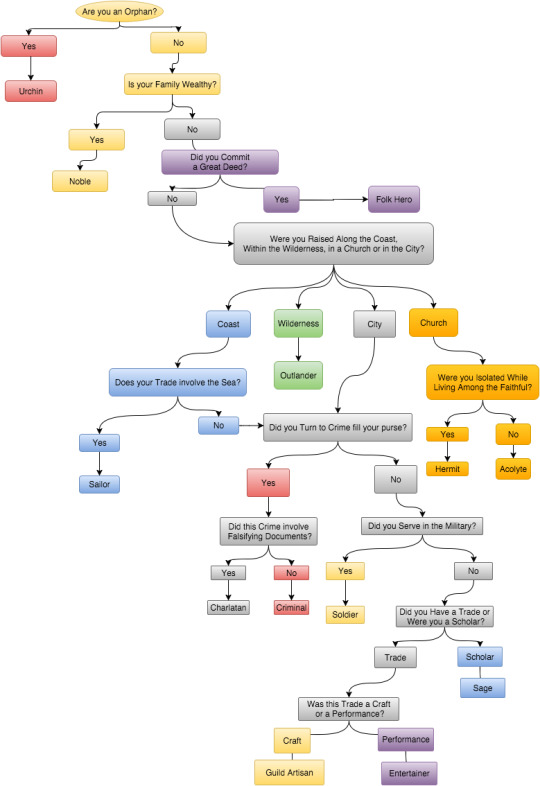
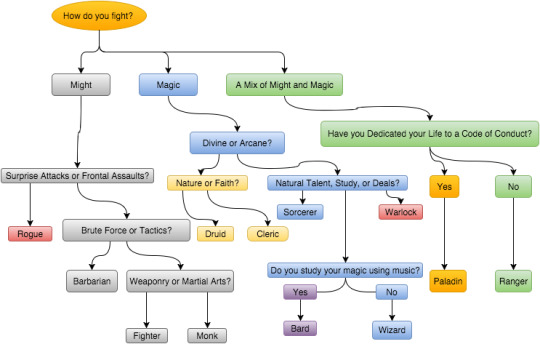
D&D 5e Character Creation Flow Charts: Backgrounds and Classes
This only includes the backgrounds included in the Player’s Handbook Mind you, so no SCAG options.
Class one doesn’t assume archetype obviously.
A fun little project I made after work today, I thought it might be helpful for players newer to the system in choosing their character’s options, or just a fun little tool.
62K notes
·
View notes
Text
How I Prepare For Major Arcs & Organize My DM Notes, As Well As Just General Narrative Advice!
So, I got a question quite a while back to try out this neat little trend of displaying and explaining away how I prepare for a session, as well as show how i organize and utilize my notes as a DM. I’m going to be using my upcoming, work-in-progress arc, “Nightingale”, as a visual reference throughout the post.
So, I know i’ve released my DM’s notes on worldanvil before, but I gotta admit that the platform I most like to use for notes and plot setup is always OneNote, which I have for free via my college. It’s versatile, organized, and easy to navigate on any platform (even my phone!). So if you can get your hands on it, I highly recommend it.
PART ONE – THE MAIN PAGE OF CENTRAL INFORMATION
What I like to do first, is create a central tab of navigation, the first thing that will pop up when I open my fresh set of notes! Things I like to include in that main tab would be any of the following:
Format Key
This will come in handy later, but essentially I have a key to differentiating different types of text throughout my notes and it looks like this (note: your notes DON’T have to look like this, but I recommend having a specific format for all these types of text to help keep you organized):
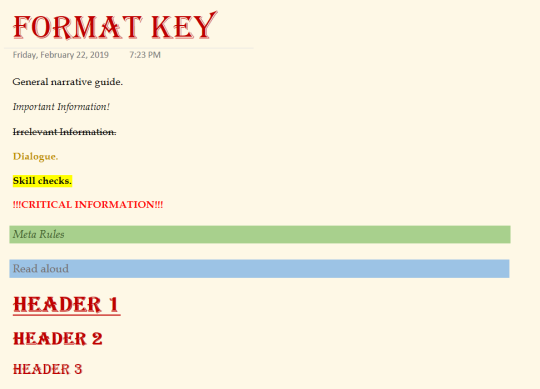
Reference Links
This is to link to articles I have on world anvil with more detailed information
Settings
NPC’s
Organizations/Factions
Misc.
Plot Setup/Brainstorming
This is helpful to get you started on your overarching plot! Be as messy as you want and DON’T DELETE ANYTHING, even if you think it’s stupid. All brainstorming is good brainstorming.
Objective
Themes
Relevant History
Hooks
Encounters
Small Outline of Main Questline
Reputation Points
I like, especially for big cities with lots of factions and NPC’s, to keep track of reputation and karma with a point system. Every good deed or bad deed, I like to record and assign a certain number of points to add or subtract from the total score of each faction, based off of just how good or bad that act was. This will help decide things in both the conclusion of that arc, as well as the conclusion of my campaign. This way, your actions really do have consequences.

PART TWO – BUILDING THE PLOT IN ACTS
So I believe it is pertinent to keep things simple when it comes to notes, especially when it comes to major arcs where your players have a lot of freedom and you need to do a lot of writing in order to allow that freedom. So i like to build in 4 acts, each of them being dedicated to its own special needs. You can add however many acts as you might need, but this is just a base line!
Act One: The Introduction
Act Two: Exploration/Information Gathering
Act Three: The Rising Action
Act Four: The Conclusion/The Climax
To add onto this, I usually put these acts as Major Groups in OneNote, and they look a little like this:

Act One; Introducing Your Players To The Setting
This, in my opinion, is the most important act of the four. I usually like to send my players into the setting with a BANG! Throw something at them that they don’t expect! An eerie exorcism, a public execution of an old friend, a plague that keeps the party away from public entrances, anything you can think of! The intro should be narrative heavy, not battle-heavy. That will just make your party snore. Give them a reason to fight, a reason to care about this story and its NPCs. Make sure that this first part is your best work, because it sets the story from here on out and will determine if your players are eager to return to the table. Do not forget to set the precedent of your arc’s main plot goal here. If you don’t do it now, it won’t make sense elsewhere. Make the PC’s care right away!
For example, some snippets of my introduction notes look a little bit like this (remember my format key from before? well here it is in use:)


Act Two; Exploration/Information Gathering
This is a big one, because this is where the majority of your work will go. This is the part where the players can roam around the setting, getting to know the NPC’s and the environment for themselves and make their own opinions on the current state of affairs wherever they are. I like to get super organized with this part, because it can get VERY hectic while going live. You want to write where you leave room for players to move, but also keep them focused on the task at hand. So whatever dialogue or side quests you introduce in exploration, keep it brief and drawing back to the central plot line at hand.
I will expand more on this in PART 3, because it deserves its own section.
Act Three; The Rising Action
Yes, just like your english teacher taught you in 6th grade, there has to be a Rising Action in your plot line! This is self explanatory, it might seem. But this is the hardest part about writing up a plot line for D&D, because you never know how your players are going to change the plot. So keep things loose and relative, allowing for wiggle room and improvisation. But still, have a decent chunk of the plot ready to go in this act, because this will be the majority of your plot and usually where the information gathering from act two will start to come in handy. Things need to start coming to a head towards the end of this act, or else you’ll be stuck with a very unsatisfactory conclusion. Another helpful tip during this act, is to write down EVERY, and I mean EVERY SINGLE LITTLE question your players might have. Figure out an answer to all of them, even if the answer is “you’ll find out later”.
Act Four; The Conclusion/The Climax
This is the end. The part of your story where everything starts to come together into a full circle! You need to be prepared to answer all those questions your players had during act three, in one form or another. There’s nothing worse than ending an arc finding that there were a million plot holes that didn’t get accounted for. So prepare, prepare, prepare for this final act. On top of that, prepare for several outcomes on top of that! Don’t be afraid to change the ending on the fly, just make sure you answer those questions somehow–be it out right, or implied in the narrative. My best advice is to not write out the ending until you’re at least half way through act three. Because your player’s choices should matter, and should have a major effect on the ending. If they don’t, then whats the point in running a narrative-heavy campaign? This is where my reputation points have come in handy in the past.
PART 3 – EXPANDING ON EXPLORATION
I wanted to give you guys a taste at how I organize my exploration section. And to be honest with you, it’s fairly to-the-point and straight forward. I’m using a city setting for my example, but I feel like this can apply to any settlement setting to be honest. But I usually like to start with a table of contents as the first page for me to land on when going to my Exploration section. It looks like this, and each link, links exactly to that page on the document so i don’t have to guess at where everything is.

I also have a page dedicated to general information about the city in my worldanvil, linked on the Reference Links page I mentioned before! But it’s always good to have a central source of information about your settlement when prepping.
Now, let’s take a look at what one of the shops looks like, as that’s most likely going to be the bulk of what you’re writing. We’re gonna start with my shop “Dagna’s General Goods Store”, which is simple enough. Here, you can see all the pages I have for this location:

These are specific to a certain encounter, but to put it in a more general sense, this is how I would organize any relevant location in a settlement:
Introduction
I like to introduce my players to the outside and inside of every establishment in my settlements. So, narrative of the outside… and then a narrative of the inside. For example, this one looks like this:

Then, from there, I can dive into whatever introducing encounters I may have planned for that shop on the same page. This is just to give the players an impression. I continue for this page like this:

I like to put in brackets before voicing a new character, how their voice may sound. But that’s just me!
The NPC(s)
Always have a page for NPC’s relative to the establishment! I usually like to link to my worldanvil at the top, but sometimes characters are so small that I don’t make them a page. For those instances, I like to write just a little bit about them under the following format:
Appearance
Personality (including voice/accent)
What They Know
Willing to Share
Not Willing to Share (requires skill checks, or otherwise)
I like to keep this brief as possible, because too much text will just overwhelm me when i’m actually DMing live. Don’t make them too complicated, unless they’re major NPC’s, otherwise you will suffer.
Whats For Sale
Self explanatory, especially for shops. If the establishment sells things, I like to take screenshots from the books and place them in this page. Or I make tables myself! Cause OneNote can do that lmao.
General Information
I like to split this up into three categories:
Schedules
What time does the establishment open and close? When is the owner there? When does the owner go to bed? Is there anything the people living there do at certain times that are of relevance? This all becomes helpful when trying to nail down routines and time tracking.
Points of Interest
Things the players can find! Maybe a secret heirloom, a private letter, or a family tree! Usually these require skill checks to find, but can also just be apart of the apparent environment!
Encounters
Events that happen to the players. This can happen at certain times, or only when the players are currently present! It’s entirely up to you. But don’t equate encounters with battle, encounters are just events, battle or otherwise!
Mine looks kind of like this, though it needs some more fleshing out– which will come with time as my plot progresses.
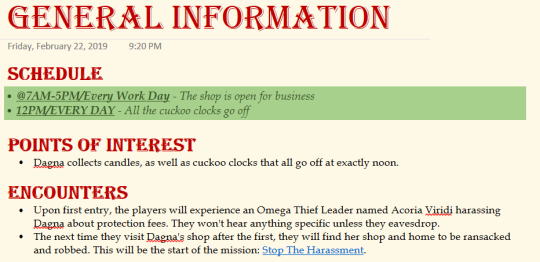
Missions (if applicable)
This can split off into various sub pages, if need be, and may not even be applicable to this specific establishment! But sometimes, you can acquire missions from people and places. I like to write the mission pages in the Establishment or NPC pages that will give them out.
And well, that’s about it! Sorry for the huge post, but it gave me some time to kill, so there you go! LOL Have fun with that, guys.
2K notes
·
View notes
Photo
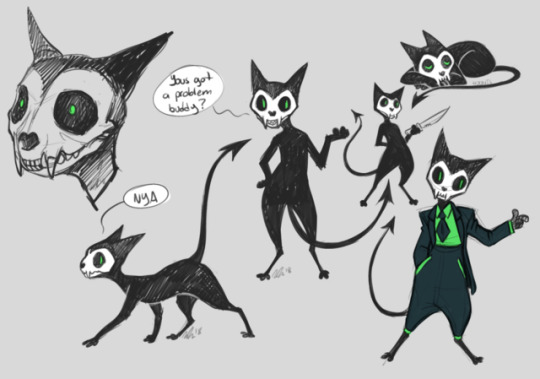
Character in my first october prompt drawing thing.
I designed him pretty recently. He’s, like, a skull faced cat demon that talks and acts like an ol’ timey mobster. He likes zuit suits and weapons that are too big for someone his size.
I’m tempted to name him Mister Whiskers.
#inspiration#npc#ok but like#so cool????#so cool!!!!#good things:#a) sass#b) crimes#c) furries#and this lil guy has everything#ok i love him
60 notes
·
View notes
Text
Retiring Adventurers
When your character decides it’s time for their adventure to end, they should think about retiring. While most PCs retire their characters after completing a campaign, a character can retire a bit early if the player has become too tired of playing them.
This is a much better option than killing them off! I can’t tell you how many times I’ve seen that question on the D&D 5e Facebook group. “How should I kill off my character?” “My DM won’t let me kill my character, what do I do?” “I want to change characters but I’m stuck as this one!”
The answer is letting your character retire. There are plenty of reasons you can come up with to write off a PC. Try one of the following or come up with one of your own.
Reasons to Stop Adventuring
Family Needs: A character’s family might take precedence from adventuring. Perhaps a loved one falls ill and you need to leave the main quest to seek out a cure on your own. Maybe your family has had children that need to be raised, and now you must leave after your brief escapade into adventuring.
Fear: Perhaps an adventurer decides that a campaign is beyond their means and is too afraid to proceed. A simple farmer that decided to adventure because they were good at killing dire rats might back down when they are told they have to slay a dragon. It’s perfectly acceptable for a hero to decide that an adventure is too dangerous and leave their party.
Wealth Satiation: An adventurer’s life is one of wealth. A pouch of gold pieces are enough for a peasant to live comfortably for a month. When an adventurer comes across a magic item and sells it for a cool 50K gp, it stands to reason that they no longer need to worry about a retirement plan. For some, this is plenty of reason to stop putting themselves in danger by delving in dungeons.
Story Satiation: Your character may have finished its story arc in the campaign. After this, they may find less reason to travel with the party and more reason to leave them. Your character’s motivations and traits have changed such that you no longer need to adventure.
Giving Up: After a great defeat where much is lost, an adventurer might be irreparably broken. They might not believe they have anything left to fight for, or any hope of success. With nothing left to drive them, they could leave the adventure to hide from whatever calamity is threatening the world.
Injury: There are some injuries that cannot be healed normally. Your adventurer could lose a limb, or become blinded or deafened, or suffer from a curse that cannot be healed. While many heroes overcome such injuries to accomplish great things, it could still be a reason for an adventurer to leave the party. Perhaps they are seeking a cure or a fix outside of the main quest, or perhaps it has broken their spirit to throw themselves at danger and they wish to retire to safety.
Love: Perhaps a hero meets the love of their life while out and abroad during an adventure. Rather than leaving them to face certain danger, they may opt to stay behind and be with them. Love is a great motivator. It can move people to face the odds, but it can also inspire them to leave their quest.
Retired Heroes
Once an adventurer retires, they become an NPC in the world. When you retire your character, you can work with your DM to figure out what happens to your former player-character once they leave the party and go about their own way. Some of these are especially awesome to use for campaigns that follow a previous one in the same setting.
Civilians: A humble hero might become a simple merchant, farmer, barkeep or the like. This NPC might just be someone that the PCs can check in on, buy things from, or just run into on return trips to town.
Plot Devices: A retired hero doesn’t always have to be great, but perhaps they have a new role in the story that they have yet to play. An old adventurer can have plenty of connections that let them weave into a new storyline. Maybe they have a piece of information or lore that the other players need later in the same story in a new campaign’s arc.
Leaders: An adventurer may become a leader within a society, or may have started their own society to lead. Perhaps the once-paladin is now a leader of the city guard. Maybe a wizard is now a wizened headmaster of a magic school. A cleric could build a new temple to their deity and begin gathering followers. Imagine being a low-level character in a new campaign and meeting your previous character, now high-level and in a seat of power!
Legends: An adventurer from a previous campaign could have become a hero of legend that disappeared or faded into myth. Some are unsure if they ever existed. But their stories remain and they are talked about with a sort of reverence. Locations or items could have been named after them, and the new or surviving PCs can discover these little easter eggs.
Hereditary Items
A really cool idea for characters that had a signature item: Hereditary Items. Not necessarily literally passed down through family, but a character could encounter a magic item or weapon that belonged to a hero PC from a previous campaign in the same setting. After their time with that hero, the item has grown and evolved, becoming greater, and now a new aspiring hero has picked it up. In time, it will become their own as well.
Don’t do this too often as it can get boring to keep finding the same items over and over, but it can be nice to find one or two on an adventure. Perhaps it is a new item that was not originally magical, but gained magic powers over the course of the hero’s adventures. Maybe the same magic that gives bards power through stories also empowers weapons through being a part of a hero’s story.
Here are some powers that an existing item could have gained:
Imparts a weaker version of a class ability the old wielder had (like sneak attack, rage, an invocation, etc)
Grants a feat that the old wielder used to have.
A weapon deals additional damage of an elemental type
A weapon gains a greater bonus to attacks/damage (+1 becomes +2, etc)
A set of armor has a greater bonus to AC (+1 becomes +2, etc)
The item can now once per day cast a spell the old wielder could cast.
Lets the attuned creature speak and understand a language the previous wielder could
An existing feature of the item is strengthened
An ability of the item with limited uses gains more of them, or gains additional charges, or lasts longer.
The item is sentient and contains the soul of the previous owner.
Or make up your own! It’s a great way to tie one campaign to the next and make heroes into legends!
#reblog#important!!! i dont want my players stuck with the same character if they don't want to#inspiration
2K notes
·
View notes
Text
A campaign where every PC is an evil alignment and the goal is to do… evil things (up to the players). Most of the large scale battles are against adventuring parties that are trying to stop them. Bonus points if one of the good adventuring parties is a party from a previous campaign that you’ve run with the same group. (Read The Tags)
52 notes
·
View notes
Text
How Sethos, the Immortal Lich Lord of the Uttercold, Spends his Copious Amount of Free Time: Part 1
I always imagined Sethos as the kind of lich who has a multitude of decoy phylacteries (as any sensible undead necromancer with Lots of time to kill does).
But then I took it a step further and imagined him having entire decoy evil lairs, each of them so elaborate and full of terror that no one would suspect that they’re not the real deal.
But not just any decoy evil lair. A Sethos decoy evil lair.
Imagine, you and your party fight your way through a whole dungeon. By the skin of your teeth, you manage to crawl your way through waves of undead minions and outwit a gauntlet of deadly traps, until you finally arrive at the most dangerous chamber of them all: Sethos’ throne room, where he guards his phylactery.
The battle is long and arduous, and several of your companions fall. The lich’s magic is powerful, and he has the guile to use it effectively. However, after a harrowing fight, you slay the necromancer and claim the wicked artifact that will rejuvenate him if not destroyed. All that’s left is to obliterate the wretched thing to ensure the lich’s permanent demise, unlock the vault, and claim whatever sweet loot lies behind its thick iron door.
But as you seize the magical object and prepare to demolish it, a magical beam emits from its surface. At first you think it to be some trap, one final layer of protection on the lich’s prized phylactery. But as you examine yourself, you notice no further harm has come to you. Instead, you look up to see the illusory image of Sethos, being projected out of the ‘phylactery,’ facing you with a skeletal grin.
“Congratulations! You have killed me!” the programmed illusion says.
“While I am regenerating back at my real lair, feel free to keep the magical key you just picked up as a souvenir of our climactic battle! If you’d prefer a more personal memento, or if more than one of you survived and you don’t feel like sharing, you can use it to open the door to the gift shop on your way out!” A translucent skeletal finger points to the ‘vault’ door.
“You can pick up a survey on your experience fighting Sethos Mardochaios from the skeleton tending the shop. Leave me your feedback and receive a free T-shirt! I hope you’ve enjoyed battling the Lich Lord of the Uttercold, and will seek me out to do battle again soon. Thank you, and have a terrible evening!”

125 notes
·
View notes